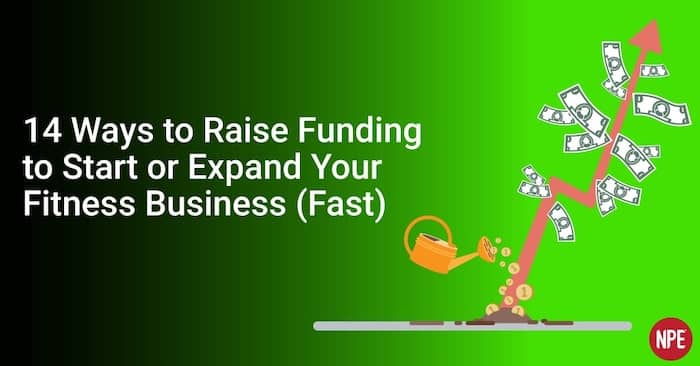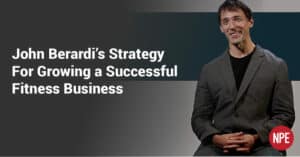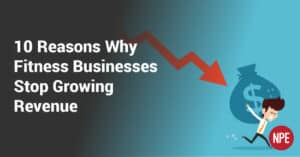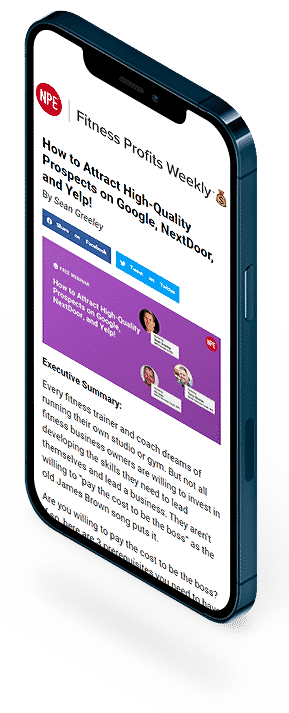14 Ways to Raise Funding to Start or Expand Your Fitness Business (Fast)
By Sean Greeley

A lot of people think they need to save for 5-10 years in order to start or grow their own business, when in fact there are a lot of strategies for raising capital that can support you in achieving your goals MUCH faster. Read on to learn more….
++++++
Do you put off plans to start, grow, or expand your fitness businesses because you’re worried about not having the capital (i.e., money)?
Like many fitness professionals and business owners, you may want to upgrade equipment or lease a bigger space or open a new location, but without capital, you can’t.
You could save up (and that’s always a good idea), but that can take a long time and cause you to miss opportunities that are happening right now.
How do get access capital if you don’t have any?
Here’s how you can raise capital when you need it for growth, for expansion, for startups, or anything that will improve your fitness business.
Options for equity financing (Sell a piece of your business)
Your first option is what’s known as equity financing.
Equity is simply value that your company has. You collect money against the value you have in your company. In exchange for someone else’s money, they get an “equity stake,” or more simply, they own a piece of your business. You see this on the television show Shark Tank all the time.
There are 4 basic strategies for raising equity financing:
1. People you know
A time-honored way of building business capital is to start with family and friends. They may not bring business expertise along with the capital, but with the right business opportunity… many would love the opportunity to put their capital to work, supporting people and causes they care about, with the opportunity for greater returns than a 2% term deposit at their local bank.
This strategy is often used for startups or if you’re looking for smaller levels of investment.
Note: You’ll want to check with a business attorney in your area to support a formal agreement. If you are issuing shares/stock, you will need to follow all applicable regulations and maintain corporate documents.
2. Wealthy individuals with expertise
So-called angel investors are wealthy private individuals (by themselves or in angel groups) who are investing their own cash.
Usually, they buy pieces of startups in areas where they have a lot of previous expertise and connections, so they may be able to offer valuable advice and to plug into their network (for example, strategic alliances.) This is often called “smart money.”
The downside is they may want a big part of your business and you may lose independence if they don’t see the results they want on their time schedule. Usually, angel investors chip in less than $100,000 but this can vary widely depending on a number of factors.
3. Private Equity Firms seeking opportunities
Not a common strategy in the fitness industry for small companies, but still important to understand how it works. Private equity firms usually seek out underperforming companies and are looking to improve their results and then sell them at a handsome profit.
Fitness entrepreneurs usually would not seek them out unless you are looking for an exit, and need capital helping you make your fitness studio more attractive to potential buyers.
4. Venture Capital
Fitness entrepreneurs would seek out venture capital for larger investments (millions), and the venture capital firm usually wants a majority equity stake and a strong say in management. We see this with successful clients that have built a great model, own a few locations, and are looking to expand into the franchising space.
They also want a big return (usually 2x their investment in 5 years) and an exit strategy. Sometimes (although rare), there might be a longer term ‘build an hold’ strategy in place with private family office type investments. These deals can be very complex (ownership stakes may change depending on performance) and you’re dealing with savvy investors who very strategic with their investments.
Debt Financing (Borrow money for your business)
Selling a piece of the ownership may not fit your goals as a fitness business owner.
Fortunately, you have a second set of options: debt financing. You borrow the capital and it can either be secured (that is, you have to put up collateral) or unsecured (no collateral … and usually this means a higher interest rate).
Let’s look at the most popular kinds of debt financing.
1. Trade or vendor credit. This means you buy something and then get invoiced, say in 30 days. If you are borrowing something (say, supplements), you expect to turn them over quickly. So the vendor ships them to you, and you pay on 30 days, 60 days, whatever your terms. In the meantime, you sell the items and use that to pay.
2. Credit Cards. This is an unsecured line of credit. Very commonly used and can be an excellent way to borrow, especially when you have introductory Interest rates of 0%. But note, these rates can rise more than 25% depending on your country’s laws. Essentially, you borrow against your future income … and is best for a “float” where you expect to earn money quickly and pay it back before you make too many interest payments. Very few tax benefits (if any).
3. Home equity line of credit. You borrow against the equity in your house. You can take out money for capital until the equity line’s limits, and then make regular payments. One “con” is you can be forced to make high payments (crimping your cash flow) even if you’ve paid back most of the loan.
4. Unsecured business line of credit. Some lenders will give you a loan based on your creditworthiness and the performance of your business. You don’t pay money back until you actually use it, and you can sometimes get up to $100,000. As you make payments, you can borrow it back (but remember you’re paying interest). Payments are usually low, protecting your cash flow.
5. Commercial bank loan or government-backed loan. Fitness entrepreneurs with great credit can get bank loans with fixed (or variable) rate payments, and these are secured loans. Basically, a mortgage. You make steady payments, which gives you predictable cash flow.
6. Cashing out or borrowing from retirement funds. This is an option. Cashing out early incurs a massive tax penalty, so you have to take that into account to determine if this is a wise investment. Borrowing against retirement funds is a better option, particularly if your interest rate is low.
7. Equipment financing. Your equipment supplier may be willing to work with you on a payment plan or leasing options to keep your payments low. If you purchase, you may have to pay a higher interest rate, depending on your credit. If you lease, you can in many countries including the U.S. write off payments as a business expense, giving you valuable tax advantages.
8. Merchant cash advance or merchant financing. Basically, you get a cash advance against future sales or credit card payments. Merchant cash advance companies are not giving you a loan. They are buying your expected sales ahead of time. Small business owners need to think seriously about this. In some cases it could be a good deal, but in others you are shrinking your cash flow month over month for a quick infusion of cash.
9. Peer Loans. These are P2P websites where you can post your individual story and get individual unsecured loans. Your credit rating and what the audience will accept will determine the interest rate. It’s good for small amounts of money.
Crowdfunding (Raise It)
One of the biggest opportunities for raising capital is the rapidly growing crowdfunding industry.
Statistics vary, but the reliable Statista analysts say there have been more than 8.7 million different campaigns raising more than $6.9 billion so far in 2019.
This number is expected to grow 14% every year through 2023–meaning there will be between $9-$12 billion raised every year in the next four years.
Crowdfunding comes in two kinds:
- Equity crowdfunding. You sell equity shares of your business
- Rewards crowdfunding: Entrepreneurs pre-sell services and products in exchange for the money.
- Gift-funding: People donate to the idea.
Kickstarter.com and Indiegogo.com are the big players.
In each case, you have less risk, and more opportunities to attract the attention of a broader audience of people (and potential clients).
The key is to have a compelling product or service and make a compelling case to attract crowdfunders. We’ve had clients who have funded the opening of their facilities/studios with crowdfunding.
Next Actions
At NPE, we have guided our fitness business clients to expand their operations and growing their businesses, and raise the capital necessary to follow their dreams and achieve their goals.
Our clients become experts in ALL the financial planning they need to grow and operate profitable fitness businesses that they are happy owning and operating. They can read their financial statements, predict their cash flow, pay down debts, and yes–raise capital to embrace opportunities they see in the market.
To learn more about telling your fitness business story “by the numbers,” schedule a call with an NPE Success Coach.
Our NPE Success Coaches have all “been there, done that” in the fitness industry and now they’re bringing their expertise to help fitness business owners like yourself clear away their biggest obstacles and show a new path forward.
When you don’t have a background in finance, raising capital can seem overwhelming to learn, set-up, and understand. But don’t let that stop you. Winners don’t avoid challenges, then face them head on.
Take charge of getting your financial house in order by scheduling a call with an NPE Success Coach today. And then get ready to grow your fitness business.







